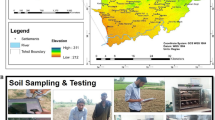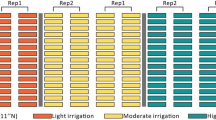Abstract
The present study aims to explore and compare the potential of different Artificial Intelligence-based Soft Computing (AISC) techniques to prepare surface Soil Moisture Content (SMC) map using fine-resolution (~ 5 m), quad-polarized Synthetic Aperture Radar (SAR) data obtained from Radar Imaging Satellite 1 (RISAT1). Potential of three different AISC techniques, i.e. Support Vector Machine (SVM), Random Forest (RF) and Genetic Programming (GP), is explored. The estimated surface SMC is validated with the field soil moisture values in both bare and vegetated lands (< 30 cm height). Different techniques have their own merits and demerits; however, we recommend GP to be most useful due to its other features. For example, GP provides the mathematical relationship, importance and sensitivity of each individual input to the surface SMC. This helps us to quantify the contribution of quad-polarized backscattering coefficients and soil texture information. It is noticed that the use of only SAR data without soil texture information may be acceptable with reasonable accuracy with an enormous benefit of its applicability to the locations without soil texture information. Using this, an exemplary fine-resolution (~ 5 m) SMC map is developed. Such high-resolution maps for large spatial extent are expected to be highly useful in many applications.



Similar content being viewed by others
References
Ahmad, S., Kalra, A., & Stephen, H. (2010). Estimating soil moisture using remote sensing data: A machine learning approach. Advances in Water Resources, 33(2010), 69–80.
Alavi, A. H., & Gandomi, A. H. (2011). A robust data mining approach for formulation of geotechnical engineering systems. Engineering Computations, 28(3), 242–274.
Breiman, L. (2001). Random forests. Machine Learning, 45, 5–32.
Coleman, M. L., & Niemann, J. D. (2012). An evaluation of nonlinear methods for estimating catchment-scale soil moisture patterns based on topographic attributes. Journal of Hydroinfomatics, 14(3), 800–814. https://doi.org/10.2166/hydro.2012.145.
Dee, D. P., Uppala, S. M., Simmons, A. J., Berrisford, P., Poli, P., Kobayashi, S., et al. (2011). The ERA-Interim reanalysis: Configuration and performance of the data assimilation system. Quarterly Journal of the Royal Meteorological Society, 137, 553–597.
El-Baroudy, I., Elshorbagy, A., Carey, S. K., Giustolisi, O., & Savic, D. (2010). Comparison of three data-driven techniques in modelling the evapotranspiration process. Journal of Hydroinformatics, 12(4), 365. https://doi.org/10.2166/hydro.2010.029.
Elshorbagy, A., & El-Baroudy, I. (2009). Investigating the capabilities of evolutionary data-driven techniques using the challenging estimation of soil moisture content. Journal of Hydroinformatics, 11(3–4), 237–251.
Espinoza-Dávalos, G. E., Arctur, D. K., Teng, W., Maidment, D. R., García-Martí, I., & Comair, G. (2016). Studying soil moisture at a national level through statistical analysis of NASA NLDAS data. Journal of Hydroinformatics, 18(2), 277–287. https://doi.org/10.2166/hydro.2015.231.
Gill, M. K., Asefa, T., Kemblowski, M., & McKee, M. (2006). Soil moisture prediction using support vector machines. Journal of the American Water Resources Association, 42(4), 1033–1046.
Han, D., Chan, L., & Zhu, N. (2007). Flood forecasting using support vector machines. Journal of Hydroinformatics, 9(4), 267–276. https://doi.org/10.2166/hydro.2007.027.
Karthikeyan, L., Pan, M., Wanders, N., Kumar, D. N., & Wood, E. (2017). Four decades of microwave satellite soil moisture observations: Part 2. Product validation and inter-satellite comparisons. Advances in Water Resources, 109, 236–252. https://doi.org/10.1016/j.advwatres.2017.09.010.
Kim, Y., Jackson, T., Bindlish, R., Lee, H., & Hong, S. (2012). Radar vegetation index for estimating the vegetation water content of rice and soybean. IEEE Geoscience and Remote Sensing Letters, 9(4), 564–568.
Kornelsen, K. C., & Coulibaly, P. (2013). Advances in soil moisture retrieval from synthetic aperture radar and hydrological applications. Journal of Hydrology, 476, 460–489.
Koza, J. (1992). Genetic programming, on the programming of computers by means of natural selection. Cambridge, MA: MIT Press.
Li, X., Sha, J., Li, Y., & Wang, Z. L. (2018). Comparison of hybrid models for daily streamflow prediction in a forested basin. Journal of Hydroinformatics, 20(1), 191–205. https://doi.org/10.2166/hydro.2017.189.
Liu, Y. Y., Dorigo, W. A., Parinussa, R. M., De Jeu, R. A. M., Wagner, W., McCabe, M. F., et al. (2012). Trend-preserving blending of passive and active microwave soil moisture retrievals. Remote Sensing of Environment, 123, 280–297. https://doi.org/10.1016/j.rse.2012.03.014.
Maity, R., & Kashid, S. S. (2011). Importance analysis of local and global climate inputs for basin-scale streamflow prediction. Water Resources Research, 47(11), W11504. https://doi.org/10.1029/2010WR009742.
Makkeasorn, A., Chang, N. B., & Li, J. (2009). Seasonal change detection of riparian zones with remote sensing images and genetic programming in a semi-arid watershed. Journal of Environmental Management, 90(2), 1069–1080.
Notarnicola, C., Angiulli, M., & Posa, F. (2008). Soil moisture retrieval from remotely sensed data: Neural network approach versus Bayesian method. IEEE Transactions on Geoscience and Remote Sensing, 46(2), 547–557.
Pal, M., Maity, R., Suman, M., Das, S. K., Patel, P., & Srivastava, H. S. (2017). Satellite based probabilistic assessment of soil moisture using C-band Quad-polarized RISAT 1 data. IEEE Transactions on Geoscience and Remote Sensing, 55(3), 1351–1362. https://doi.org/10.1109/TGRS.2016.2623378.
Paloscia, S., Pettinato, S., Santi, E., Notarnicola, C., Pasolli, L., & Reppucci, A. (2013). Soil moisture mapping using Sentinel-1 images: Algorithm and preliminary validation. Remote Sensing of Environment, 134, 234–248.
Pasolli, L., Notarnicola, C., Bertoldi, G., Bruzzone, L., Remelgado, R., Greifeneder, F., et al. (2015). Estimation of soil moisture in mountain areas using SVR technique applied to multiscale active radar images at C-band. IEEE Journal of Selected Topics in Applied Earth Observations and Remote Sensing, 8(1), 262–283.
Rodríguez-Fernández, N. J., Aires, F., Richaume, P., Kerr, Y. H., Prigent, C., Kolassa, J., et al. (2015). Soil moisture retrieval using neural networks: Application to SMOS. IEEE Transactions on Geoscience and Remote Sensing, 53(11), 5991–6007.
Rutkowski, L., Jaworski, M., Pietruczuk, L., & Duda, P. (2015). A new method for data stream mining based on the misclassification error. IEEE Transactions on Neural Networks and Learning Systems, 26(5), 1048–1059.
SAC. (2015). RISAT-1 Data products format—version 1.4, Space Applications Centre, Indian Space 627 Research Organization, Ahmedabad, India, September, 2015. https://nrsc.gov.in/sites/all/pdf/format3.pdf. Accessed March 2018.
Schmidt, M., & Lipson, H. (2009). Distilling free-form natural laws from experimental data. Science, 324(5923), 81–85.
Ulaby, F., Moore, R., & Fung, A. (1982). Microwave remote sensing: active and passive. Volume III, from theory to application. Dedham, MA: Artech House.
Unnikrishnan, P., & Jothiprakash, V. (2017). Data-driven multi-time-step ahead daily rainfall forecasting using singular spectrum analysis-based data pre-processing. Journal of Hydroinformatics, jh2017029. https://doi.org/10.2166/hydro.2017.029.
Zribi, M., Baghdadi, N., Holah, N., & Fafin, O. (2005). New methodology for soil surface moisture estimation and its application to ENVISAT-ASAR multi-incidence data inversion. Remote Sensing of Environment, 96(3), 485–496.
Acknowledgements
This study is partially supported by a research project sponsored by the Space Application Centre (SAC), Indian Space Research Organization (ISRO), Govt. of India (Ref No.: IIT/SRIC/CE/VIR/2016-17/88).
Author information
Authors and Affiliations
Corresponding author
Additional information
Publisher's Note
Springer Nature remains neutral with regard to jurisdictional claims in published maps and institutional affiliations.
Electronic supplementary material
Below is the link to the electronic supplementary material.
About this article
Cite this article
Pal, M., Maity, R. Soil Moisture Retrieval Using Quad-Polarized SAR Data from Radar Imaging Satellite 1 (RISAT1) Through Artificial Intelligence-Based Soft Computing Techniques. J Indian Soc Remote Sens 47, 1671–1682 (2019). https://doi.org/10.1007/s12524-019-01015-4
Received:
Accepted:
Published:
Issue Date:
DOI: https://doi.org/10.1007/s12524-019-01015-4




